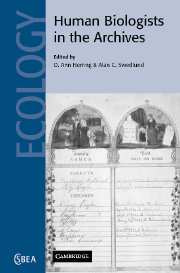 Human Biologists in the Archives
Human Biologists in the Archives Published online by Cambridge University Press: 12 August 2009
Introduction
During the nineteenth century in North America, the erection of custodial institutions, such as prisons and asylums for the mentally ill, initiated a legacy of long-term inmate care, structured around social and medical philosophy, which has persisted to the present day (Dwyer 1987; Foucault 1965; Grob 1994; Phillips 2001; Rothman 1995). The historiography of those institutions demonstrates that inmates were viewed as social deviants and potentially threatening to the fabric of society. As such, the purpose of the emergent nineteenth-century institutions, from prisons to asylums, was to attempt to reform the inmates for possible return to mainstream society. In this effort, inmates' lives were structured around contemporary medical and sociological concepts of normalcy (Dwyer 1987; Ferguson 1994; Rothman 1995). In the attempt to institute normalcy, asylum superintendents hoped to shepherd inmates' habits away from deviant behaviors and within the sphere of normalcy. In this atmosphere, inmates of long-term custodial institutions were exposed to regimens established to bring about normalcy, in many cases, for their entire adult lives. The aim of this study is to examine some of the biological consequences, in the skeletal record, to inmates of long-term custodial institutions who were exposed to socially and medically prescribed regimens. Some basic questions this study poses include: How can the skeletal record be utilized to test hypotheses generated from the historical record? Since institutional inmates were virtually a voiceless group, how can we recover their day-to-day experiences?
To save this book to your Kindle, first ensure [email protected] is added to your Approved Personal Document E-mail List under your Personal Document Settings on the Manage Your Content and Devices page of your Amazon account. Then enter the ‘name’ part of your Kindle email address below. Find out more about saving to your Kindle.
Note you can select to save to either the @free.kindle.com or @kindle.com variations. ‘@free.kindle.com’ emails are free but can only be saved to your device when it is connected to wi-fi. ‘@kindle.com’ emails can be delivered even when you are not connected to wi-fi, but note that service fees apply.
Find out more about the Kindle Personal Document Service.
To save content items to your account, please confirm that you agree to abide by our usage policies. If this is the first time you use this feature, you will be asked to authorise Cambridge Core to connect with your account. Find out more about saving content to Dropbox.
To save content items to your account, please confirm that you agree to abide by our usage policies. If this is the first time you use this feature, you will be asked to authorise Cambridge Core to connect with your account. Find out more about saving content to Google Drive.